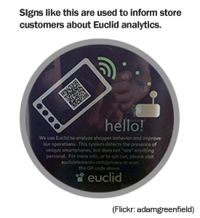Customer experience pioneer and retail giant, Nordstrom, recently found itself in hot water over customer privacy. They’d been operating a pilot program in the Dallas-Fort Worth area for a special technology that tracks shopper’s in-store foot traffic via cell phone signals.
The appeal is obvious, and significant; Nordstrom isn’t alone in this test. But in an ever-more transparent world, the risks can be significant as well. Once you know the facts, any outcry over this issue seems overblown. But it still offers a few lessons for others who may want to experiment.
Google Analytics for Physical Retail
The technology that Nordstrom was piloting is from a firm called Euclid Analytics. Think of it as a Google Analytics for physical retail locations; now that almost all cell phones have wi-fi, the periodic pulses of data used to find available wireless networks can act as a sort of beacon.

Euclid uses these pulses to reconstruct shopper locations and foot traffic patterns; when someone moves closer to one access point and farther from others, the change in signal strength can be used to approximate the device’s location.
To be clear, retailers can’t personally identify any individual (and attempts to do so violate Euclid’s terms of service). But some critics bristle at the idea anyway, and when it comes to customer experience perception IS reality.
Is Anonymous Tracking an Invasion of Privacy?
There’s a major disconnect between marketers and consumers on this issue. On one hand, you have Nordstrom’s spokesperson stating, “This is literally measuring a signal. You are not connected to the signal.” But many consumers feel incredibly creeped out by this kind of data collection. One said, “Now that I know they're tracking me, I'm a little less likely to shop in their store.”
The irony of this situation is that Euclid Analytics provides significantly more consumer privacy protection than ubiquitous technologies ranging from in-store cameras and data mining over purchase histories, to “liking” a brand on Facebook.
But none of that matters unless you properly communicate to your customers, and that’s where this pilot project started to come off the rails.
Three Lessons Learned: What Nordstrom Did Right (and Wrong)
Thinkers throughout history - from Spiderman to Voltaire - have taught us: “With great power comes great responsibility.” And while Big Data gives companies of all kinds the power to serve customers better than ever, most simply use it to serve themselves – almost guaranteeing a backlash at some point.
When it comes to leveraging the disruptive force of Pervasive Memory and the power of Big Data to further your agenda, here are three take-aways that can help you balance privacy and customer experience, and hopefully avoid a Big Data bite.
- Use Data to Better Serve, Not Just to Better Sell to, Your Customers: Last year I wrote about a radical idea: using customer data to actually benefit your customers. That means using data to do things like simplify touchpoints, improve customer experience, and improve processes. These things bring your customers closer to you. Using data simply to up sell, cross sell, or advertise—effective as it may be—often erodes your customer relationships instead. Nordstrom could have leveraged this initiative to create new, helpful services that make their customers lives easier. They didn't.
- Be Careful How You Communicate; Transparency is Key: With Big Data initiatives (as with almost anything that touches customers), the best practice is to effectively communicate what you’re doing and why you’re doing it. Unfortunately, Nordstrom’s communications were limited to signs that explained what they were doing in techno-jargon that customers would find hard to understand (if they even saw or bothered to read the sign). Companies often make this mistake in an attempt to avoid attention. But guess what? They often get more attention as a result.
- Starting Small Can Avoid Big Problems: There’s a reason this story hasn’t turned into a huge social media and PR nightmare. Nordstrom intelligently rolled this out in a limited test. I don’t know if Nordstrom intended to use the pilot to gauge customer reaction, but it obviously provided key insights. No company can reliably predict customer reaction to new ideas, and focus groups aren’t always a reliable way to test new concepts like this. A focused pilot like this can tell you exactly how customers will respond to an initiative, without exposing you to risk across your entire customer base. Good move.
Nordstrom has a long track record of delivering great customer experience, and they’re a model company for many others. What happened wasn’t in any way a failing of their customers or a betrayal of values, and other from a vocal minority I don't think it was viewed as such by their legions of loyal customers.
The fact is, figuring out how to leverage the benefits and balance the risks of disruptive, digitally-driven innovation is still new territory that’s being explored. And when a recognized customer-experience leader such as Nordstrom comes this close to getting bit, it’s important for everyone to recognize that even well-meaning pioneers need to watch their step.

